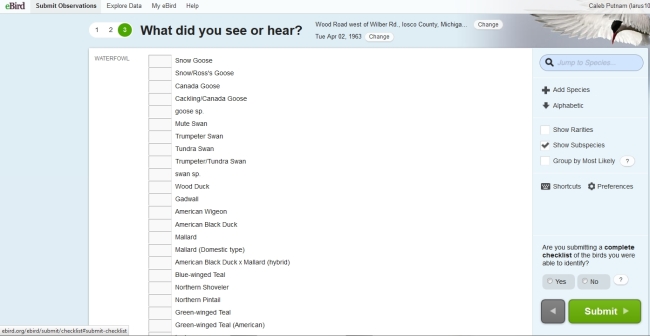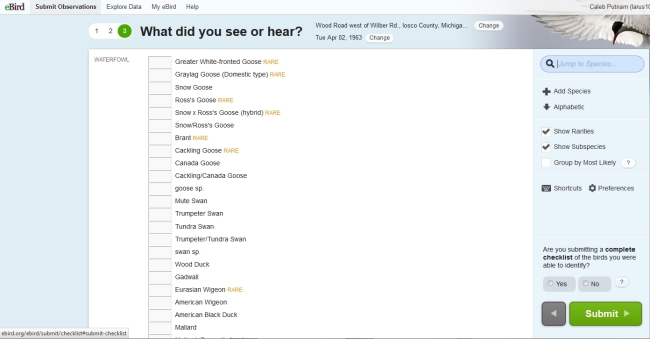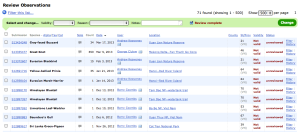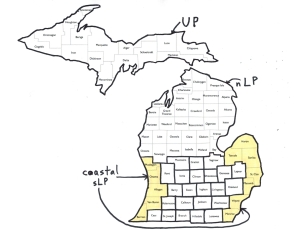So you’re entering a checklist into eBird, either through the ‘submit checklist’ area of ebird.org, or from the BirdLog application (which is *must-have*, and works on both Apple and Android operating systems). You enter the date and your birding location, and it then pauses briefly while it pulls up a checklist. Where does this list come from, and what does it mean?
The answer: the Michigan eBird filters. eBird filters tell users what species are expected and rare at that date and location. Filters can be set down to the county level, or up to the state level. They are set manually, species by species. Each bird is given a threshold number for each time period, with a sliding date range bar chosen by the reviewer. The system allows up to 13 date range bars per species, to allow for different thresholds at different times. Let’s look at an example (flycatchers in the Jackson Co. filter):
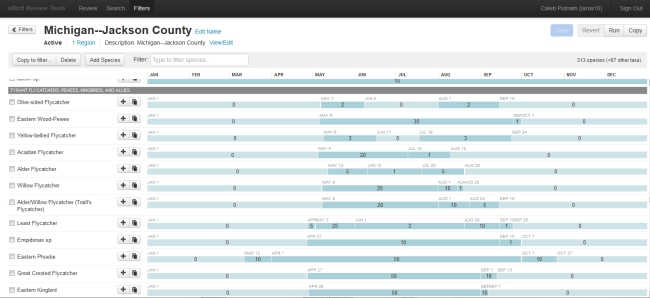
Notice how each species’s window opens and closes on a specific date, and that the number of birds allowed during those date ranges can be set as high as one wishes. Reviewers spend a lot of time adjusting these totals to most accurately reflect the distribution and phenology of each species at the local level, a process which takes an incredible amount of effort.
Now, if you’re entering from the internet, notice the box in the right column entitled ‘show rarities’. When unclicked, the checklist will only include species set above zero for that exact date (in this case April 2):
But when you click the box, it will now show all species including rarities (ie. those set to zero for that date):
In BirdLog this is accomplished by toggling between the ‘likely’ tab (no rarities):
and the ‘all’ tab (rarities plus expected species):
Any time a user submits a number higher than that allowed on that date (or a species not on the checklist at all), the record will ‘flag’, and the user will be asked to submit additional documentation to corroborate the record. Each of these ‘flagged’ records, statewide, is then automatically added to the Michigan eBird Review Queue, where it awaits action by the statewide reviewer overseeing that county. Here is a screenshot of the eBird Review queue, from another article on this topic authored by national eBird staff:
As time is available, reviewers individually go through these records and either validate or invalidate them based upon his/her opinion of whether the documentation meets a minimum standard of identification for the species claimed. These decisions can be exceedingly difficult for reviewers, and are NOT based on the reputation of the birder. Most importantly: any time a record flags, we ask that all users please include full documentation of the record without being asked by the reviewer. Otherwise, the reviewer spends valuable volunteer time unnecessarily sending correspondences, rather than clearing records from the queue or adjusting the filters (or authoring another blog post!). But rest assured, if you forget, we will ask you. Also: if you are repeatedly eBirding a known rarity which has already been validated, a simple ‘continuing rarity’ in the species comments box will do.
Back to the Michigan eBird filters. About 2-3 years ago, some of the county-specific filters established for Michigan were apparently inadvertently lost, and replaced with a generic statewide filter that none of the state reviewers had ever seen. As a result, our filters have been in relative state of disarray, ever since. Many species were set to improper time periods (such as allowing for Double-crested Cormorants in the Upper Peninsula in February!), counties (such as Spruce Grouse and Kirtland’s Warbler in Oceana County), and threshold levels (such as 50,000 Herring Gulls during winter, when 8,000 would be an exceptional count anywhere). These examples are the tip of the iceberg, representing in total thousands of such errors. Until now, Team eBird Michigan has not had ample time to fix them. But Caleb Putnam has been slowly chipping away at them for almost 2 years and is now nearing a major plateau in this endeavor (see below).
Here is the current grouping of counties in the Michigan filters, with notes on what we are doing to improve them:
1) Upper Peninsula (all 15 counties). All 15 counties are going to be split into unique, county-level filters. eBird usership in the UP is still at a relatively low level, and we hope these drastically fine-tuned filters will instigate a surge in interest.
2) northern Lower Peninsula (all 33 counties north of a line from Muskegon Co. to Tuscola Co.). We are in the process of deciding how to split these counties. 33 individual county level filters probably aren’t necessary in this heavily under-eBirded region. At the very least, users can expect to see coastal vs inland filters separated, and inland filters constituting anywhere from one to several counties, to account for distributional oddities such as Kirtland’s Warbler and Evening Grosbeak, which do not occur evenly throughout this region.
3) southern Lower Peninsula (shown in yellow, all 12 coastal counties from Muskegon to Berrien and Tuscola/Huron to Monroe). This filter is about to be split into 10 separate filters, with the only lumped filter being Tuscola/Huron/Sanilac Counties. This change is badly needed, as there are major distributional rifts between Lakes Huron, Erie, and Michigan, and between these counties. Long-tailed Duck, for example, numbers in the thousands from Muskegon to Van Buren Cos. in mid-winter, but is very uncommon on Lake Erie. There are hundreds more examples which will be fixed after this long-awaited split.
4) inland southern Lower Peninsula filters (Each of the 21 inland counties south of the Muskegon Co. to Tuscola Co. line already has its own unique filter). These counties will need fewer tweaks and fixes than all previous filters, but are certainly not yet perfect. Suggested changes to any Michigan filters should be forwarded to Caleb Putnam.
In summary, we are currently preparing for a major splitting of filters in Michigan, which will drastically fine-tune the process for all users. We will go from having 26 filters for the state to around 60-65, with the majority of the state subsequently having county-specific filters. We are also hoping to create 4-5 additional *site-specific* filters for exceptional sites such as Whitefish Point, Pointe Mouillee State Game Area, Shiawassee National Wildlife Refuge, and Muskegon Wastewater Complex, so that the huge numbers of birds at these hotspots are not being allowed in other sites in those counties. Users can expect the filters to remain frustratingly poor in certain areas until this tedious process is over, so we ask for your patience over the next 6-12 months. Birders at Muskegon Wastewater, for instance, will continue to have to put up with Eared Grebe, Ruddy Duck, and Northern Shovelers flagging at low levels (so that these species aren’t being allowed, for example, in places where large counts are rare, such as Sanilac and Wayne Counties), and Berrien County users will have to put up with Yellow-throated Warblers and Prairie Warblers flagging at relatively low levels as well.
We hope this gives you a better understanding of the functioning of Michigan’s eBird filters, and of the amount of work that the reviewers are doing to improve them. We also hope that you’ll take notice of the many drastic improvements to the Michigan filters that are being implemented behind the scenes over the next several months.

